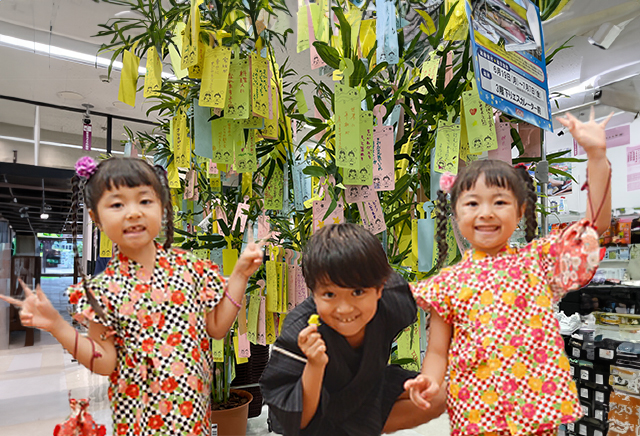Tanabata sama
Sasanoha sarasara nokibani yureru
Ohoshisama kirakira kingin sunagoGoshiki no tanzaku watashi ga kaita
Ohoshi sama kirakira sorakara miteruLyricist:GONDOU Hanayo
supplementary poetry:HAYASHI Ryuha(credit~2044)
Composer:SHIMOFUSA Kanichi
in 1941
Legend of the summer star
The leaves of the bamboo are soothing
Sway to the edge of the eaves
The stars are sparkling again and again
Gold and silver and their fine powder
Five colored strips
Besides that I wrote a wish
The stars are sparkling again and again
They are watching me from the sky

Tanabata sama — When Summer Stars Come Alive in Song
“Tanabata-sama” is more than just a children’s song – it’s a musical gateway to one of Japan’s most enchanting summer traditions. This beloved melody celebrates Tanabata, a festival that transforms the ordinary evening of July 7th into something truly magical. The name itself tells a story: written in kanji as “七夕” (literally “seven evenings”), Tanabata is also known as the Star Festival, and for good reason. As twilight descends on this special night, families across Japan gather to look up at the summer sky, searching for the celestial drama that has captivated hearts for over a millennium.

The festival represents a beautiful blend of ancient Chinese legend and distinctly Japanese customs, creating a celebration that feels both timeless and intimate. What makes Tanabata particularly special is how it connects the vastness of the universe with the simple hopes and dreams of everyday people. When children sing “Tanabata-sama,” they’re not just performing a cute song – they’re participating in a tradition that links them to countless generations who have gazed at the same stars and wished upon the same cosmic love story.
A Love Story Written in the Stars
At the heart of Tanabata lies one of the most romantic tales ever told, a story so beautiful it has inspired countless songs, poems, and festivals. Picture Orihime, the weaving goddess whose star we know as Vega in the constellation Lyra. She was so dedicated to her craft – creating the most exquisite fabrics in all of heaven – that she never took time to care for her own appearance or seek companionship. On the other side of the celestial realm lived Hikoboshi (known to us as Altair in the constellation Aquila), a diligent cowherd who spent his days tending cattle and working the heavenly fields with unwavering dedication.
The gods, moved by the loneliness of these two hardworking souls, arranged for them to meet through the mediation of Deneb in the constellation Cygnus. Together, these three stars form what astronomers call the “Great Summer Triangle,” a brilliant celestial landmark that dominates the summer sky. When Orihime and Hikoboshi met, it was love at first sight – a romance so powerful it literally changed the heavens. Their wedding was celebrated throughout the cosmos, and for a brief, shining moment, perfect happiness reigned in the celestial realm.
But love, as beautiful as it can be, sometimes comes with consequences that even the gods didn’t foresee.

When Love Disrupts the Universe
The newlyweds were so intoxicated with their happiness that they completely abandoned their duties. Orihime’s loom fell silent, and no more beautiful fabrics graced the heavens. Hikoboshi’s cattle wandered aimlessly while he spent his days gazing lovingly at his bride. The cosmic order itself began to unravel as these essential workers forgot everything except each other. The supreme deity, witnessing this celestial dereliction of duty, made a decision that would break hearts across the universe.
In divine anger, he separated the lovers, placing them on opposite sides of the vast Milky Way – Orihime in the west and Hikoboshi in the east. The silver river of stars that had once seemed so beautiful now became an insurmountable barrier, keeping the lovers apart for eternity. Or almost eternity. Moved by their tears and genuine remorse, the gods granted them one precious gift: once each year, on the seventh day of the seventh month, magpies would form a bridge across the Milky Way, allowing the lovers to reunite for a single, precious night.
This is why Tanabata carries such a bittersweet beauty – it celebrates not just love, but love that endures separation, distance, and the inexorable passage of time. Every July 7th, as people across Japan look up at the summer sky, they’re witnessing this eternal love story play out among the stars.

From Ancient Legend to Modern Celebration
Today’s Tanabata has evolved into something wonderfully accessible and family-friendly, though it retains all the magic of its ancient origins. What makes this festival particularly special is how it brings joy to children across Japan. In kindergartens and preschools throughout the country, little hands eagerly grasp crayons and markers to write their innocent wishes on colorful strips of paper called “tanzaku” – perhaps hoping for a new bicycle, asking for their pet hamster to stay healthy, or wishing to become a superhero when they grow up. These precious handwritten dreams are then carefully tied to bamboo branches, creating wish trees that flutter like prayer flags in the summer breeze.
The festival has also become a cornerstone of Japan’s early summer atmosphere, transforming ordinary spaces into magical wonderlands. Shopping malls compete to create the most enchanting Tanabata displays, with elaborate decorations cascading from ceilings and bamboo groves appearing in unexpected corners. These commercial celebrations serve a beautiful purpose – they bring the ancient tradition into modern daily life, allowing busy families to pause and participate in this timeless ritual of hope. You’ll find these charming displays everywhere during Tanabata season, from grand installations at department stores to simple bamboo branches in local supermarkets, each one representing someone’s heartfelt hopes for the future.

Interestingly, weather forecasters have become unofficial participants in the Tanabata tradition. Every year on July 7th, they invariably comment on the evening’s weather conditions, and there does seem to be an unusually high probability of rain on this night. With a twinkle in their eyes, meteorologists often explain this as “the tears of Orihime and Hikoboshi” – either tears of joy at their reunion or tears of sorrow at their brief time together. While we might laugh at the idea that earthbound weather has anything to do with cosmic romance, there’s something delightfully poetic about the notion that even the skies participate in this ancient love story.
The most spectacular modern Tanabata celebrations take place in Sendai City, Miyagi Prefecture, where the entire downtown area transforms into a wonderland of colorful streamers and elaborate decorations. But perhaps the true magic of Tanabata lies not in the grand festivals, but in those quiet moments when families gather to sing “Tanabata-sama” and look up at the summer stars, connecting their own hopes and dreams to a love story that has been unfolding in the heavens for over a thousand years.
▼This is another shrine where the tragic love story of Tanabata has been passed down. It is also known as the ‘Hoshi jinjya (Star Shrine)’.
Firefly and hotel packages? For luxury stay and dinner reservations, please contact us.
![]()






コメント